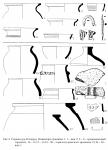Summary (English)
In 2007 an expedition of the Uzhgorod National University started investigation ata site in the north-east part of Uzhgorod at Rotonda (a natural boundary). A road section was carried out over 50m. In it was found thebank (1, 2 m inheight, 4 m in width ) and ditch ( 1, 4 m in depth) of the fortifications. The area of hillfort was 1, 05 ha. The fortifications consisted of the rampart and ditсh.
The cultural layer was 0,4–1, 4 m in depth. There were sherds, flint flakes, bones and iron objects. The finds came from the mesolithic, Hallstatt, 3–4th cent. AD, 11–12th cent. AD, and 15–16th cent. AD. A lot of the pottery of the 15–16 th cent. AD was found inside the hill fort. Pottery of the 3–4th cent. AD was found at ground level in hillfort. This pottery was represented by hand-made pots, bowls, covers and gray-polished wheel-made bowls with stamped ornament. These types are typical of theLate Roman period of the Upper Tysa river.
Mesolithic flint flakes and Hallstatt pottery were found in the south part of the road cutting outside of the hill fort. The items (gray-polished pottery) in the road cutting showed that the hill fort had been built in the Late Roman period, although such construction is not typical for that period. More research is needed to clarify the date of the construction of the hillfort.






![Download [PDF]](/excavation/skins/fasti/images/results/download_sml.png)